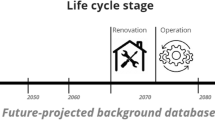Abstract
In recent years, computerized mathematical modelling has enabled construction-related problems to be resolved and predictions to be made regarding the behaviours of buildings and their environments in a more rigorous fashion than was the case with the deterministic models used until now. This model enables the analysis of a simulation of the sustainability of the use of timber as a major structural component in construction. Thus, using a unique model, which could be adapted to the particular characteristics of any country, the viability of a sustainable use of woodland can be verified, with extraction rates below 100 %, in order to supply an industry which accounts for a high percentage of the carbon dioxide emissions released into the atmosphere. In the specific case of Spain, the demographic forecasts for the next 40 years were used as the basis on which to establish the operational period of the model. For this period, the different variables involved in the natural production of wood were compared, along with felling strategies. The results point to sustainable scenarios for the most part during the target period in Spain, with the most unfavourable combinations of the variables preventing the sustainability of the use of timber from being achieved.
Graphical Abstract








Similar content being viewed by others
References
Anbumozhi V, Gunjima T, Prem Ananth A, Visvanathan C (2010) An assessment of inter-firm networks in a wood biomass industrial cluster: lessons for integrated policymaking. Clean Technol Environ Policy 12:365–372
Bare JC (2013) Development of impact assessment methodologies for environmental sustainability. Clean Technol Environ Policy. doi:10.1007/s10098-013-0685-4
Cabezas H, Pawlowski CW, Mayer AL, Hoagland T (2003) Sustainability: ecological, social, economic, technological, and systems perspectives. Clean Technol Environ Policy 5:167–180
De la Riva JM, Palacios A, Vinuesa J (2008) The phenomenon of unoccupied homes (in Spanish). Foundation of the Autonomous University of Madrid, Madrid
Dieguez Aranda U (2009) Tools for the sustainable management of forests in Galicia (in Spanish). Regional Government of Galicia, Galicia
Ingwersen WW, Garmestani AS, Gonzalez MA, Templeton JJ (2013) A systems perspective on responses to climate change. Clean Technol Environ Policy. doi:10.1007/s10098-012-0577-z
Milutiene E, Staniskis JK, Krucius A, Augulien V, ArdickasIncrease D (2012) Increase in buildings sustainability by using renewable materials and energy. Clean Technol Environ Policy 14:1075–1084
Sikdar SK (2009) Quo vadis energy sustainability? Clean Technol Environ Policy 11:367–369
Universitat Politècnica de València (2012). Wolfram Mathematica (version 8.0.1.0). Oxfordshire: Wolfram Research. www.wolfram.com/mathematica/. Accessed 28 Feb 2014
Various authors (2005) National Forestry Inventory 3. Ministry of Agriculture, Food and the Environment. Madrid (in Spanish)
Various authors (2007) PNAP, the National Priority Action plan for Reforestation for the Prevention of Soil Erosion. Ministry of Agriculture, Food and the Environment. Madrid (in Spanish)
Various authors (2009) Construction Statistics. National Statistical Institute. Madrid (in Spanish)
Various authors (2009) Informative Bulletin of the National Statistical Institute. National Statistical Institute. Madrid (in Spanish)
Various authors (2010). Current Situation of Forests and the Forestry Sector in Spain, 2010 Report. Spanish Society for Forestry Science. Asturias (in Spanish)
Various authors (2010) Forest Fires in Spain 2009. Ministry of Agriculture, Food and the Environment. Madrid (in Spanish)
Various authors (2010) Long-term Population Projection for Spain, 2009-2049. National Statistical Institute. Madrid (in Spanish)
Various authors (2012) Policies for the future. 2011 assessment of country energy and climate policies. World Energy Council, London
Various authors (2012) 2011 Yearbook of Property Registry Statistics. College of Property Registrars, Madrid (in Spanish)
Various authors (2012) Construction Statistics. Ministry of Public Works, Madrid (in Spanish)
Verges R (2011) Asymmetric information in the Spanish property sector (2). Observatory of the property and construction industries, Madrid48:52–59 (in Spanish)
Yeheyis M, Hewage K, Alam MS, Eskicioglu C, Sadiq R (2013) An overview of construction and demolition waste management in Canada: a lifecycle analysis approach to sustainability. Clean Technol Environ Policy 15:81–91
Author information
Authors and Affiliations
Corresponding author
Rights and permissions
About this article
Cite this article
Fernández, M., Martínez, A., Alonso, A. et al. A mathematical model for the sustainability of the use of cross-laminated timber in the construction industry: the case of Spain. Clean Techn Environ Policy 16, 1625–1636 (2014). https://doi.org/10.1007/s10098-014-0738-3
Received:
Accepted:
Published:
Issue Date:
DOI: https://doi.org/10.1007/s10098-014-0738-3




